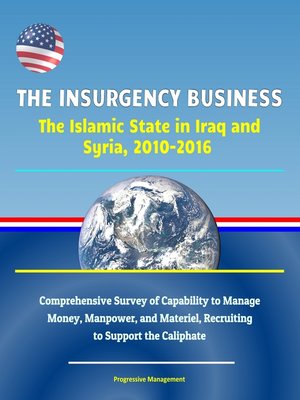The Insurgency Business
ebook ∣ The Islamic State in Iraq and Syria, 2010-2016--Comprehensive Survey of Capability to Manage Money, Manpower, and Materiel, Recruiting to Support the Caliphate

Sign up to save your library
With an OverDrive account, you can save your favorite libraries for at-a-glance information about availability. Find out more about OverDrive accounts.
Find this title in Libby, the library reading app by OverDrive.



Search for a digital library with this title
Title found at these libraries:
| Library Name | Distance |
|---|---|
| Loading... |
This fascinating and comprehensive December 2017 report has been professionally converted for accurate flowing-text e-book format reproduction.
The Islamic State (IS)—also known as Islamic State of Iraq and the Syria (ISIS)—managed to seize large swaths of territory within the sovereign countries of Iraq and Syria from 2011 to 2016. Even though its caliphate has been reduced in size and scope in 2017, the IS's entrepreneurial capability to effectively manage money, manpower, and materiel has enabled it to develop its brand as the deadliest and most widely known terrorist organization. The narrative of the IS being a governing body promoted a value proposition of financial stability, security, religious structure for divine worship, and camaraderie, thus enticing local and global customers to its brand and furthermore allowing the group to recruit talented individuals to support the caliphate. Using the human capital it cultivated, the IS developed its organizational structure and promoted its brand through entrepreneurial ingenuity, which included plundering, fabricating, and acquiring war materiel, to support its strategic objectives. The IS is generally more organized and sophisticated than any other regional non-state actor or traditional terrorist group such as Al-Qaeda. In conclusion, the IS's short-term politico-military successes and global media coverage over the last several years have enabled the group to establish a franchise that draws in the money, manpower, and materiel that allow it to continue being the world's most recognized terrorist brand.
I. INTRODUCTION * A. THE ISLAMIC STATE TODAY * B. SCOPE AND METHODOLOGY * C. RESEARCH QUESTIONS * D. BENEFITS OF RESEARCH * E. ORGANIZATION OF STUDY * II. MONEY * A. FINANCIAL ENTERPRISE * 1. Strategy * 2. Financial Structure * B. REVENUE STREAMS * 1. Oil and Natural Gas * 2. Taxation and Extortion * 3. Commercial Enterprises and Agriculture * 4. Cash from the Banking System * 5. Kidnapping for Ransom * 6. Antiquities Trade * 7. Human Smuggling and Trafficking * 8. Donations * 9. Total Revenues * C. EXPENDITURES * 1. Fighters' Salaries * 2. War Materiel * 3. Propaganda * 4. Public Services * D. SUMMARY * III. MANPOWER * A. ORGANIZATIONAL AND HIERARCHICAL STRUCTURE * 1. 2004 to 2013: AQI and ISI * 2. 2013 to Present: ISIS and IS * B. THE CALIPHATE'S WORKFORCE * 1. Foreign Fighters * 2. Local Fighters * 3. Supporting Personnel and Female Involvement * 4. IS Global Affiliates * 5. Talent Management * 6. The Islamic State Capacity * C. SUMMARY * IV. MATERIEL * A. SPOILS OF WAR * 1. Iraq * 2. Syria * B. THE ISLAMIC STATE'S INDUSTRIAL BASE * 1. Home-Grown Ordnance and Ammunition * 2. The Workshop * 3. Intermediaries, Gunrunners, Smugglers, and the Black Market * 4. Logistical Competency * C. SUMMARY * V. CONCLUSIONS AND RECOMMENDATIONS * A. THE FRANCHISE * B. RECOMMENDATIONS FOR POLICYMAKERS * C. RECOMMENDATIONS FOR FUTURE AREAS OF STUDY * D. SUMMARY







